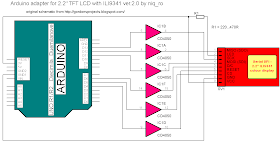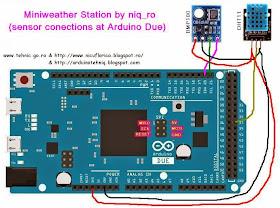I use TinyGPS++ library made by Mikal Hart and I extract speed:
TinyGPSCustom zdop(gps, "GPVTG", 7); // $GPVTG sentence, 7th elementI designed this schematic for tests:
// source: http://arduiniana.org/libraries/tinygpsplus/
// for see your position: http://www.gps-coordinates.net/
// for new article made by niq_ro: http://nicuflorica.blogspot.com/
// & http://arduiniq.blogspot.com/
#include <TinyGPS++.h>
#include <SoftwareSerial.h>
/*
This sample code demonstrates the normal use of a TinyGPS++ (TinyGPSPlus) object.
It requires the use of SoftwareSerial, and assumes that you have a
4800-baud serial GPS device hooked up on pins 4(rx) and 3(tx).
*/
static const int RXPin = 4, TXPin = 3;
static const uint32_t GPSBaud = 4800;
// The TinyGPS++ object
TinyGPSPlus gps;
// The serial connection to the GPS device
SoftwareSerial ss(RXPin, TXPin);
#include <LiquidCrystal.h>
// folosesc libraria pentru afisaje LCD simple
LiquidCrystal lcd(7, 8, 9, 10, 11, 12);
// indic modul de legare, vezi mai jos:
/* -------------------
| LCD | Arduino |
-------------------
LCD RS pin to digital pin 7 | RS | D7 |
LCD Enable pin to digital pin 6 | E | D8 |
LCD D4 pin to digital pin 5 | D4 | D9 |
LCD D5 pin to digital pin 4 | D5 | D10 |
LCD D6 pin to digital pin 3 | D6 | D11 |
LCD D7 pin to digital pin 2 | D7 | D12 |
LCD R/W pin to ground | R/W | GND |
-------------------
niq_ro adapted this sketch for see data on 2004 LCD
*/
/* A set of custom made large numbers for a 16x2 LCD using the
LiquidCrystal library. Works with displays compatible with the
Hitachi HD44780 driver. Made by Michael Pilcher, 2/9/2010
*/
int x = 0;
// the 8 arrays that form each segment of the custom numbers
byte LT[8] =
{
B00111,
B01111,
B11111,
B11111,
B11111,
B11111,
B11111,
B11111
};
byte UB[8] =
{
B11111,
B11111,
B11111,
B00000,
B00000,
B00000,
B00000,
B00000
};
byte RT[8] =
{
B11100,
B11110,
B11111,
B11111,
B11111,
B11111,
B11111,
B11111
};
byte LL[8] =
{
B11111,
B11111,
B11111,
B11111,
B11111,
B11111,
B01111,
B00111
};
byte LB[8] =
{
B00000,
B00000,
B00000,
B00000,
B00000,
B11111,
B11111,
B11111
};
byte LR[8] =
{
B11111,
B11111,
B11111,
B11111,
B11111,
B11111,
B11110,
B11100
};
byte UMB[8] =
{
B11111,
B11111,
B11111,
B00000,
B00000,
B00000,
B11111,
B11111
};
byte LMB[8] =
{
B11111,
B00000,
B00000,
B00000,
B00000,
B11111,
B11111,
B11111
};
// for speed in knots (noduri)
//TinyGPSCustom sdop(gps, "GPVTG", 5); // $GPVTG sentence, 5th element
// for speed in kilometers per hour
TinyGPSCustom zdop(gps, "GPVTG", 7); // $GPVTG sentence, 7th element
void setup()
{
Serial.begin(115200);
ss.begin(GPSBaud);
Serial.println(F("FullExample.ino"));
Serial.println(F("An extensive example of many interesting TinyGPS++ features"));
Serial.print(F("Testing TinyGPS++ library v. ")); Serial.println(TinyGPSPlus::libraryVersion());
Serial.println(F("by Mikal Hart"));
Serial.println();
Serial.println(F("Sats HDOP Latitude Longitude Fix Date Time Date Alt Course Speed Card Distance Course Card Chars Sentences Checksum"));
Serial.println(F(" (deg) (deg) Age Age (m) --- from GPS ---- ---- to London ---- RX RX Fail"));
Serial.println(F("---------------------------------------------------------------------------------------------------------------------------------------"));
lcd.begin(20, 4); // set up the LCD's number of columns and rows:
// assignes each segment a write number
lcd.createChar(8,LT);
lcd.createChar(1,UB);
lcd.createChar(2,RT);
lcd.createChar(3,LL);
lcd.createChar(4,LB);
lcd.createChar(5,LR);
lcd.createChar(6,UMB);
lcd.createChar(7,LMB);
lcd.clear(); // clear the screen
lcd.setCursor(1, 0); // put cursor at colon x and row y
lcd.print("GPS data - 7.2014"); // print a text
lcd.setCursor(0, 1); // put cursor at colon x and row y
lcd.print("ver 1.6.5 by niq_ro"); // print a text
lcd.setCursor(1, 2); // put cursor at colon x and row y
lcd.print("Craiova - Romania"); // print a text
lcd.setCursor(0, 3); // put cursor at colon x and row y
lcd.print("(TinyGPS++ library)"); // print a text
delay (2000);
lcd.clear(); // clear the screen
/*
// testare la inceput mod afisare viteza
lcd.setCursor(2,0);
lcd.print("niq_ro testeaza");
lcd.setCursor(1,1);
lcd.print("afisarea vitezei:");
for (int q=0; q<120; q=q++)
{
vitezamare(q);
lcd.setCursor(12,3);
lcd.print("km/h");
delay(200);
lcd.setCursor(0,2);
lcd.print(" ");
lcd.setCursor(0,3);
lcd.print(" ");
}
*/
lcd.clear(); // clear the screen
delay(500);
}
void loop()
{
// partea de ecran LCD 20x4
afisareecran();
// scot viteza
int viteza = atoi (zdop.value());
//int viteza = 123;
//int viteza = 456;
//int viteza = 789;
//int viteza = 92;
//int viteza = 6;
//int viteza = 0;
vitezamare(viteza);
lcd.setCursor(12,3);
lcd.print("km/h");
static const double LONDON_LAT = 51.508131, LONDON_LON = -0.128002;
printInt(gps.satellites.value(), gps.satellites.isValid(), 5);
printInt(gps.hdop.value(), gps.hdop.isValid(), 5);
printFloat(gps.location.lat(), gps.location.isValid(), 11, 6);
printFloat(gps.location.lng(), gps.location.isValid(), 12, 6);
printInt(gps.location.age(), gps.location.isValid(), 5);
printDateTime(gps.date, gps.time);
printFloat(gps.altitude.meters(), gps.altitude.isValid(), 7, 2);
printFloat(gps.course.deg(), gps.course.isValid(), 7, 2);
printFloat(gps.speed.kmph(), gps.speed.isValid(), 6, 2);
printStr(gps.course.isValid() ? TinyGPSPlus::cardinal(gps.course.value()) : "*** ", 6);
unsigned long distanceKmToLondon =
(unsigned long)TinyGPSPlus::distanceBetween(
gps.location.lat(),
gps.location.lng(),
LONDON_LAT,
LONDON_LON) / 1000;
printInt(distanceKmToLondon, gps.location.isValid(), 9);
double courseToLondon =
TinyGPSPlus::courseTo(
gps.location.lat(),
gps.location.lng(),
LONDON_LAT,
LONDON_LON);
printFloat(courseToLondon, gps.location.isValid(), 7, 2);
const char *cardinalToLondon = TinyGPSPlus::cardinal(courseToLondon);
printStr(gps.location.isValid() ? cardinalToLondon : "*** ", 6);
printInt(gps.charsProcessed(), true, 6);
printInt(gps.sentencesWithFix(), true, 10);
printInt(gps.failedChecksum(), true, 9);
// speed in km/h
Serial.print(" ");
Serial.print(zdop.value());
int vitesa1 = atoi (zdop.value());
Serial.print("/");
Serial.print(vitesa1);
Serial.println();
smartDelay(1000);
if (millis() > 5000 && gps.charsProcessed() < 10)
Serial.println(F("No GPS data received: check wiring"));
}
// This custom version of delay() ensures that the gps object
// is being "fed".
static void smartDelay(unsigned long ms)
{
unsigned long start = millis();
do
{
while (ss.available())
gps.encode(ss.read());
} while (millis() - start < ms);
}
static void printFloat(float val, bool valid, int len, int prec)
{
if (!valid)
{
while (len-- > 1)
Serial.print('*');
Serial.print(' ');
}
else
{
Serial.print(val, prec);
int vi = abs((int)val);
int flen = prec + (val < 0.0 ? 2 : 1); // . and -
flen += vi >= 1000 ? 4 : vi >= 100 ? 3 : vi >= 10 ? 2 : 1;
for (int i=flen; i<len; ++i)
Serial.print(' ');
}
smartDelay(0);
}
static void printInt(unsigned long val, bool valid, int len)
{
char sz[32] = "*****************";
if (valid)
sprintf(sz, "%ld", val);
sz[len] = 0;
for (int i=strlen(sz); i<len; ++i)
sz[i] = ' ';
if (len > 0)
sz[len-1] = ' ';
Serial.print(sz);
smartDelay(0);
}
static void printDateTime(TinyGPSDate &d, TinyGPSTime &t)
{
if (!d.isValid())
{
Serial.print(F("********** "));
}
else
{
char sz[32];
sprintf(sz, "%02d/%02d/%02d ", d.month(), d.day(), d.year());
// sprintf(sz, "%02d/%02d/%02d ", gps.date.month(), gps.date.day(), gps.date.year());
Serial.print(sz);
}
if (!t.isValid())
{
Serial.print(F("******** "));
}
else
{
char sz[32];
sprintf(sz, "%02d:%02d:%02d ", t.hour(), t.minute(), t.second());
// sprintf(sz, "%02d:%02d:%02d ", gps.time.hour(), gps.time.minute(), gps.time.second());
Serial.print(sz);
}
printInt(d.age(), d.isValid(), 5);
smartDelay(0);
}
static void printStr(const char *str, int len)
{
int slen = strlen(str);
for (int i=0; i<len; ++i)
Serial.print(i<slen ? str[i] : ' ');
smartDelay(0);
}
static void afisareecran()
{
// lcd.clear(); // clear the screen
// partea de ora
// ora de vara a Romaniei -
// trebuie sa pun un comutator pentru selectie de iarna si de vara
int ora = 3 + gps.time.hour();
if (ora ==24) ora=0;
if (ora ==25) ora=1;
if (ora ==26) ora=2;
lcd.setCursor(12,2); // put cursor at colon 2 and row 2
if (ora<10) lcd.print(" ");
lcd.print(ora);
lcd.print(":");
if (gps.time.minute()<10) lcd.print("0");
lcd.print(gps.time.minute());
lcd.print(":");
if (gps.time.second()<10) lcd.print("0");
lcd.print(gps.time.second());
// parte de coordonate GPS
lcd.setCursor(0,0); // put cursor at colon 0 and row 0 = left/up
lcd.print("LAT:");
lcd.print(gps.location.lat(),6);
lcd.write(0b11011111);
lcd.setCursor(0,1); // put cursor at colon 0 and row 1
lcd.print("LON:");
lcd.print(gps.location.lng(),6);
lcd.write(0b11011111);
// numar sateliti receptionati
lcd.setCursor(16,0); // put cursor at colon 15 and row 2
lcd.print(gps.satellites.value());
// if (gps.satellites.value() == 1) lcd.print(" satelit ");
// else
lcd.print("sat");
// viteza
/*
lcd.setCursor(10,3); // put cursor at colon x and row y
double viteza = gps.speed.kmph();
// tests
// double viteza = 0.;
// double viteza = 5;
// double viteza = 14;
// double viteza = 104;
if (viteza>100.0) lcd.print(viteza);
else
if (viteza>10.0) {lcd.print(" "); lcd.print(viteza);}
else
if (viteza<10.0) {lcd.print(" "); lcd.print(viteza);}
// lcd.print(viteza);
// lcd.print(gps.speed.kmph());
lcd.print("km/h");
*/
/*
// altitudine
lcd.setCursor(16,0); // put cursor at colon 16 and row 0
lcd.print("ALT:");
int cota = gps.altitude.meters();
lcd.setCursor(15,1); // put cursor at colon 15 and row 1
// cota=5;
//cota=15;
//cota=497;
//cota=2056;
if (cota>1000) lcd.print(cota);
else
if (cota>100) {lcd.print(" "); lcd.print(cota);}
else
if (cota>10) {lcd.print(" "); lcd.print(cota);}
if (cota<10) {lcd.print(" "); lcd.print(cota);}
lcd.print("m");
*/
/*
// viteza extrasa custom
lcd.setCursor(0,3); // put cursor at colon x and row y
lcd.print("viteza: ");
int viteza = atoi (zdop.value());
// lcd.print(zdop.value());
if (viteza>100.0) lcd.print(viteza);
else
if (viteza>10.0) {lcd.print(" "); lcd.print(viteza);}
else
if (viteza<10.0) {lcd.print(" "); lcd.print(viteza);}
lcd.print("km/h");
*/
}
void custom0O() // uses segments to build the number 0
{
lcd.setCursor(x, 2);
lcd.write(8);
lcd.write(1);
lcd.write(2);
lcd.setCursor(x, 3);
lcd.write(3);
lcd.write(4);
lcd.write(5);
}
void custom1()
{
lcd.setCursor(x,2);
lcd.write(1);
lcd.write(2);
lcd.setCursor(x,3);
lcd.write(4);
lcd.write(255);
lcd.write(4);
}
void custom2()
{
lcd.setCursor(x,2);
lcd.write(6);
lcd.write(6);
lcd.write(2);
lcd.setCursor(x, 3);
lcd.write(3);
lcd.write(7);
lcd.write(7);
}
void custom3()
{
lcd.setCursor(x,2);
lcd.write(6);
lcd.write(6);
lcd.write(2);
lcd.setCursor(x, 3);
lcd.write(7);
lcd.write(7);
lcd.write(5);
}
void custom4()
{
lcd.setCursor(x,2);
lcd.write(3);
lcd.write(4);
lcd.write(2);
lcd.setCursor(x+2, 3);
lcd.write(255);
}
void custom5()
{
lcd.setCursor(x,2);
lcd.write(255);
lcd.write(6);
lcd.write(6);
lcd.setCursor(x, 3);
lcd.write(7);
lcd.write(7);
lcd.write(5);
}
void custom6()
{
lcd.setCursor(x,2);
lcd.write(8);
lcd.write(6);
lcd.write(6);
lcd.setCursor(x, 3);
lcd.write(3);
lcd.write(7);
lcd.write(5);
}
void custom7()
{
lcd.setCursor(x,2);
lcd.write(1);
lcd.write(1);
lcd.write(2);
lcd.setCursor(x+1, 3);
lcd.write(8);
}
void custom8()
{
lcd.setCursor(x,2);
lcd.write(8);
lcd.write(6);
lcd.write(2);
lcd.setCursor(x, 3);
lcd.write(3);
lcd.write(7);
lcd.write(5);
}
void custom9()
{
lcd.setCursor(x,2);
lcd.write(8);
lcd.write(6);
lcd.write(2);
lcd.setCursor(x, 3);
lcd.write(7);
lcd.write(7);
lcd.write(5);
}
// subrutina de afisare a numerelor
void afisarenumar(int numar)
{
switch (numar)
{
case 0:
custom0O();
break;
case 1:
custom1();
break;
case 2:
custom2();
break;
case 3:
custom3();
break;
case 4:
custom4();
break;
case 5:
custom5();
break;
case 6:
custom6();
break;
case 7:
custom7();
break;
case 8:
custom8();
break;
case 9:
custom9();
break;
}
}
void vitezamare(int viteza)
{
// sterg zona de afisare a vitezei
lcd.setCursor(0,2);
lcd.print(" ");
lcd.setCursor(0,3);
lcd.print(" ");
if (viteza>=100)
{
x = 0;
afisarenumar(int(viteza/100));
viteza=viteza % 100;
x = x + 4;
afisarenumar(viteza/10);
x = x + 4;
afisarenumar(viteza % 10);
}
else
if (viteza>=10)
{
lcd.setCursor(0,2);
lcd.print(" ");
lcd.setCursor(0,3);
lcd.print(" ");
x = 4;
afisarenumar(viteza/10);
x = x + 4;
afisarenumar(viteza % 10);
}
else
if (viteza<10)
{
lcd.setCursor(0,2);
lcd.print(" ");
lcd.setCursor(0,3);
lcd.print(" ");
x = 8;
afisarenumar(viteza);
}
}
Also, I made few movies:
Bibliography:






















